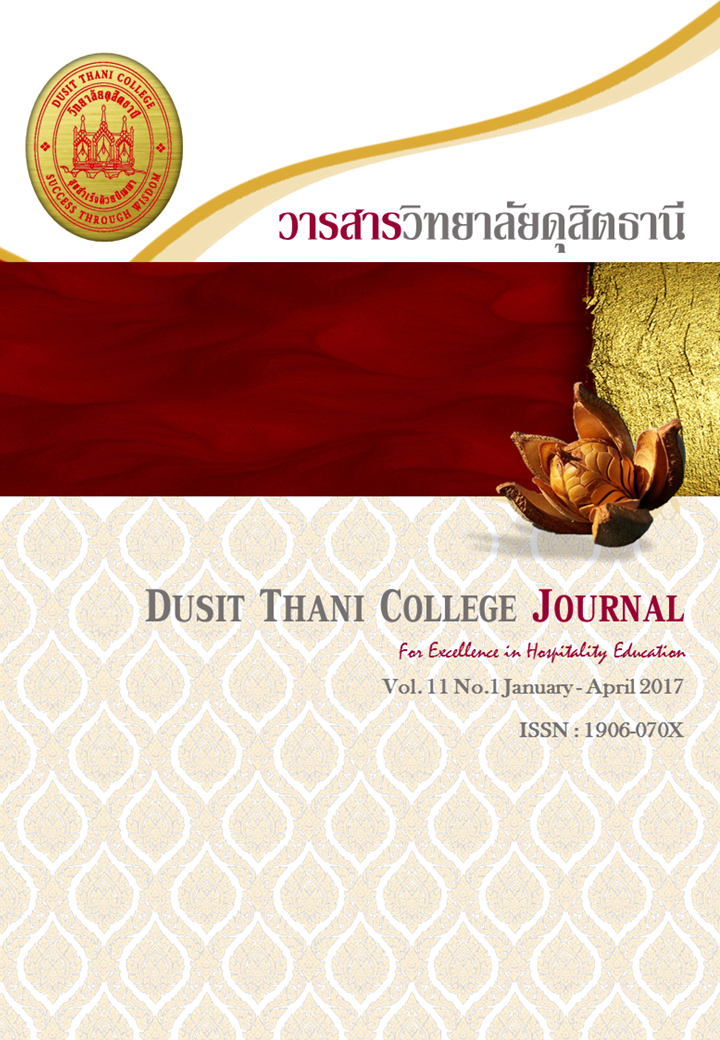A Comparison Analysis of Job Retention of Hotel Staff between International Hotel Chains and Local Hotel Chains: A Case Study of Intercontinental Bangkok Hotel and Centara Grand Hotel at Central World
Main Article Content
Abstract
The objectives of this study were to study the factors influencing the job retention of hotel staff of local hotel chains and international hotel chains, to examine the factors influencing for job retention of hotel staff in comparison between the international hotel chains and local hotel chains.
This is quantitative research that the data was collected by questionnaire and conducted from 520 hotel staff which is delivered to InterContinental Hotel Bangkok for 280 questionnaires and to Centara Grand hotel at Central World for 240 questionnaires. The data was analyzed by frequency, percentage, mean, and standard deviation. The hypotheses were tested by T-Test, F-Test and Multiple Regression statistic.
The result showed the majority of both respondents were females, in the age range of 25 or below to 35 year olds, single status, Thai nationality, graduated with a Bachelor’s degree, earning monthly around 15,001 – 25,000 baht and the majority of both hotels staff worked as officer position. In terms of hypotheses testing, both of demographic factor and human resource management factors have influenced hotel staff decision making on job retention of international hotel chains and local hotel chains.
Article Details
Article Screening Policy
- All research and academic articles to be published must be considered and screened by three peer reviews in the relevant field / article.
- All articles, texts, illustrations and tables published in the journal are the personal opinions of the authors. Editors don't always have to agree. And no responsibility whatsoever is the sole responsibility of the author.
- The articles to be published must never be published. Where did you first publish? And not in the consideration of other journals If the audit found that there has been a duplicate publication It is the sole responsibility of the author.
- Any article that the reader sees as being plagiarized or impersonated without reference. Or mislead the work of the author Please let the journal editor know it will be your greatest blessing.
References
http://geert-hofstede.com/national-culture.html (Accessed 24 October 2013)
Gmj. (2006). Gallup Study: Engaged employees inspire company innovation. Gallup Management Journal, http://gmj.gallup.com/content/default.aspx?ci=24880&pg=1.
Harrell,M.,Kavanagh,J.,Lim,N.,Marquis, J.andScott,L. (2008). “Managing diversity in corporate America”., 1st Ed., USA Rand corporation.
Hubbard,E. (2011). “The diversity Scorecard (improving human performance). 1st ed. Rutledge
IHGanualreport. (2014). “About InterContinental Hotels Group”. Retrieved from http://www.ihg.com/hotels/gb/en/global/about#scmisc=nav_about_6c
Iorgulessu and Ravar. (2014). "Expatriate Hotel Manager’s Perspective on Cross-Cultural Skills". Retrieved from http://www.sea.bxb.ro/Article/SEA_3_31.pdf
Islam and Siengtha. (2009). “Quality of work life and organizational performance: Empirical evidence from Dhaka Export Processing Zone”. Retrieved from http://www.ilo.org/legacy/english/protection/travail/pdf/rdwpaper37a.pdf
Joonrachat,T. (2013, September 10). Helping organization work. Retrieved from
http://www.manager.co.th/iBizChannel/ViewNews.aspx?NewsID=9560000114064
Kawar.T. (March 2012). “Cross-cultural Differences in Management”. Retrieved from http://www.ijbssnet.com/journals/Vol_3_No_6_Special_Issue_March_2012/13.pdf
Kiruthiga.V, Magesh.R. (2014). “Brunt of Employee Retention Strategies on Job Satisfaction”. Retrieved from
http://www.researchpublish.com/journal/IJMCI/Issue-2-October-2014-March-2015/30
Koonponkeaw.J. (2014). bangkokbiznews.com. “Quality of work life”. Retrieved from http://www.tia.or.th/main.php?m=article&id=21
Kysilak and Csab. (2013). “Employee turnover in hospitality industy”. Retrieved from
http://search.proquest.com/openview/0d76b87258fe8f31858fda865dc2f6f4/1.pdf?pq-origsite=gscholar&cbl=2029256
Limyothin, P. (2012). Structural Equation Model of Factors Influencing the Hotel Staff in Thailand’s Intention to Quit. Retrieved from http://kb.psu.ac.th/psukb/bitstream/2010/8845/1/365501.pdf
Logan, J. K. (2000). Retention tangibles and intangibles: More meaning in work is essential, but good chair massages won’t hurt. Training & Development, 54 (4), 48-50.
Msengeti D and Obwogi. J.(2015). “Effects of Pay and Work Environment on Employee Retention: A Study of Hotel Industry in Mombasa County”. Retrieved from http://www.ijsrp.org/research-paper-0415/ijsrp-p4077.pdf
Ranganayakulu, (2004). Directory of Commerce and Management, Atlantic Publishers and Distributors, New Delhi, 212.
Samuel,M & Chipunza,C. (2009). “Employee retention and turnover: Using Motivational variables as a panacea”. Retrieved from
http://www.academicjournals.org/app/webroot/article/article1380550130_Samuel%20 and%20Chipunza%20pdf.pdf
Simons, T., & Enz, C. A. (1995). Motivating hotel employees: Beyond the carrot and the stick [Electronic version]. Cornell Hotel and Restaurant Administration Quarterly, 36(1), 20-27. Retrieved from http://scholarship.sha.cornell.edu/articles/477/
Ukessays.com. (2015). “Importance Of HRM In Hospitality Industry Tourism Essay”. Retrieved from http://www.ukessays.com/essays/tourism/importance-of-hrm-in- hospitality-industry-tourism-essay.php.
Zineldin, M. (2000). TRM Total Relationship Management, Student litterateur, Lund.


